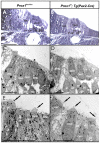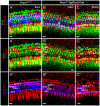Canal cristae growth and fiber extension to the outer hair cells of the mouse ear require Prox1 activity
- PMID: 20186345
- PMCID: PMC2826422
- DOI: 10.1371/journal.pone.0009377
Canal cristae growth and fiber extension to the outer hair cells of the mouse ear require Prox1 activity
Abstract
Background: The homeobox gene Prox1 is required for lens, retina, pancreas, liver, and lymphatic vasculature development and is expressed in inner ear supporting cells and neurons.
Methodology/principal findings: We have investigated the role of Prox1 in the developing mouse ear taking advantage of available standard and conditional Prox1 mutant mouse strains using Tg(Pax2-Cre) and Tg(Nes-Cre). A severe reduction in the size of the canal cristae but not of other vestibular organs or the cochlea was identified in the E18.5 Prox1(Flox/Flox); Tg(Pax2-Cre) mutant ear. In these mutant embryos, hair cell differentiated; however, their distribution pattern was slightly disorganized in the cochlea where the growth of type II nerve fibers to outer hair cells along Prox1 expressing supporting cells was severely disrupted. In the case of Nestin-Cre, we found that newborn Prox1(Flox/Flox); Tg(Nestin-Cre) exhibit only a disorganized innervation of outer hair cells despite apparently normal cellular differentiation of the organ of Corti, suggesting a cell-autonomous function of Prox1 in neurons.
Conclusions/significance: These results identify a dual role of Prox1 during inner ear development; growth of the canal cristae and fiber guidance of Type II fibers along supporting cells in the cochlea.
Conflict of interest statement
Figures










Similar articles
-
Expression of Prox1 during mouse cochlear development.J Comp Neurol. 2006 May 10;496(2):172-86. doi: 10.1002/cne.20944. J Comp Neurol. 2006. PMID: 16538679 Free PMC article.
-
Prox1 interacts with Atoh1 and Gfi1, and regulates cellular differentiation in the inner ear sensory epithelia.Dev Biol. 2008 Oct 1;322(1):33-45. doi: 10.1016/j.ydbio.2008.07.004. Epub 2008 Jul 9. Dev Biol. 2008. PMID: 18652815
-
Localization of efferent neurotransmitters in the inner ear of the homozygous Bronx waltzer mutant mouse.Hear Res. 2002 May;167(1-2):136-55. doi: 10.1016/s0378-5955(02)00382-9. Hear Res. 2002. PMID: 12117537
-
Anatomical and physiological development of the human inner ear.Hear Res. 2016 Aug;338:9-21. doi: 10.1016/j.heares.2016.02.004. Epub 2016 Feb 18. Hear Res. 2016. PMID: 26900072 Review.
-
Mutant mice reveal the molecular and cellular basis for specific sensory connections to inner ear epithelia and primary nuclei of the brain.Hear Res. 2005 Aug;206(1-2):52-63. doi: 10.1016/j.heares.2004.11.025. Hear Res. 2005. PMID: 16080998 Free PMC article. Review.
Cited by
-
Neuroanatomical Tracing Techniques in the Ear: History, State of the Art, and Future Developments.Methods Mol Biol. 2016;1427:243-62. doi: 10.1007/978-1-4939-3615-1_14. Methods Mol Biol. 2016. PMID: 27259931 Free PMC article. Review.
-
Current concepts in cochlear ribbon synapse formation.Synapse. 2019 May;73(5):e22087. doi: 10.1002/syn.22087. Epub 2019 Feb 18. Synapse. 2019. PMID: 30592086 Free PMC article. Review.
-
Embryology, Malformations, and Rare Diseases of the Cochlea.Laryngorhinootologie. 2021 Apr;100(S 01):S1-S43. doi: 10.1055/a-1349-3824. Epub 2021 Apr 30. Laryngorhinootologie. 2021. PMID: 34352899 Free PMC article.
-
Prickle1 regulates neurite outgrowth of apical spiral ganglion neurons but not hair cell polarity in the murine cochlea.PLoS One. 2017 Aug 24;12(8):e0183773. doi: 10.1371/journal.pone.0183773. eCollection 2017. PLoS One. 2017. PMID: 28837644 Free PMC article.
-
Secreted factor R-Spondin 2 is involved in refinement of patterning of the mammalian cochlea.Dev Dyn. 2013 Feb;242(2):179-88. doi: 10.1002/dvdy.23908. Dev Dyn. 2013. PMID: 23192966 Free PMC article.
References
Publication types
MeSH terms
Substances
Grants and funding
LinkOut - more resources
Full Text Sources
Molecular Biology Databases
Research Materials
Miscellaneous

